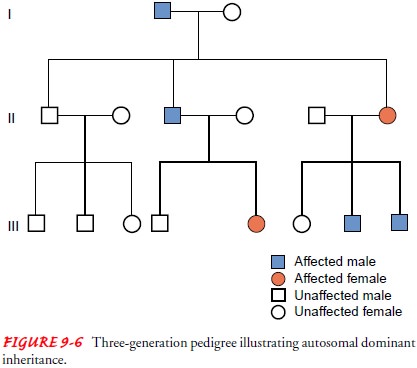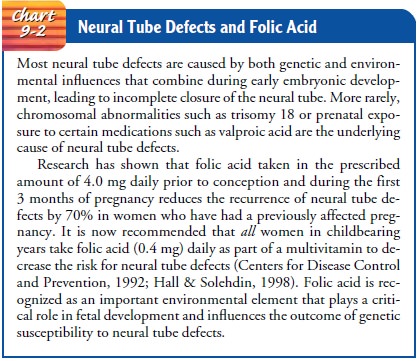Chapter: Medical Surgical Nursing: Genetics Perspectives in Nursing
Inheritance Patterns in Families - Genetics Concepts

INHERITANCE
PATTERNS IN FAMILIES
Nursing assessment of
patients’ health includes obtaining and recording family history information.
Family history evaluation in the form of a pedigree
is a first step in establishing the pattern of inheritance. Nurses must become
familiar with mendelian pat-terns of inheritance and pedigree construction and
analysis to be able to help identify individuals and families who may benefit
from further genetic counseling, testing and therapeutics (Lea, Jenkins &
Francomano, 1998; Lea, 2000).
Mendelian conditions are genetic conditions that are inher-ited in families in fixed proportions among generations. Named after Gregor Mendel, mendelian conditions result from gene mu-tations present on one or both chromosomes of a pair. An indi-vidual gene inherited from one or both parents can cause a mendelian inherited condition. Mendelian conditions are classi-fied according to their pattern of inheritance in families: auto-somal dominant, autosomal recessive, and X-linked. The terms dominant and recessive refer to the trait, genetic condition, orphenotype, but not to the genes or alleles that cause the observ-able characteristics (Thompson et al., 2001).
Autosomal Dominant Inheritance
Autosomal dominant inherited conditions affect female and male family members equally and follow a vertical pattern of inheritance in families (Fig. 9-6). An individual who has an au-tosomal dominant inherited condition carries a gene mutation for that condition on one chromosome of a pair. Each of that individual’s offspring has a 50% chance of inheriting the gene mutation for the condition and a 50% chance of inheriting the normal version of the gene. Offspring who do not inherit the gene mutation for the dominant condition will not develop the condition and do not have an increased chance for having children with the same condition (Fig. 9-7). Table 9-1 presents characteristics and examples of different patterns of inherited conditions.



Autosomal dominant
inherited conditions often present with varying degrees of severity among
affected family members and persons. Some individuals with the condition may
have signifi-cant symptoms, while others may have only mild ones. This
char-acteristic is referred to as variable
expression; it results from the influences of genetic and environmental
factors on clinical pre-sentation.
Another phenomenon observed in autosomal dominant in-heritance is penetrance, the percentage of persons known to have a particular gene mutation who actually show the trait. Penetrance is observed in conditions such as achondroplasia, in which nearly 100% of persons with the gene mutation typically display traits of the disease. In some conditions, the presence of a gene mutation does not invariably mean that a person will have or develop an autosomal inherited condition. For exam-ple, a woman who has the BRCA1 hereditary breast cancer gene mutation has a lifetime risk for breast cancer up to 80%, not 100%. This quality, known as incomplete penetrance, indicates the probability that a given gene will produce disease. In other words, a person may inherit the gene mutation that causes an autosomal dominant condition but may not have any of the ob-servable physical or developmental features of that condition. However, these individuals carry the gene mutation and still have a 50% chance of passing the gene for the condition to each of their children. One of the effects of incomplete penetrance is that the gene appears to “skip” a generation, thus leading to er-rors in interpreting family history and in genetic counseling. Examples of other genetic conditions with incomplete penetrance include otosclerosis (40%) and retinoblastoma (80%) (Lashley, 1998).
Autosomal Recessive Inheritance
The pattern of inheritance
in autosomal recessive inherited con-ditions differs from that of autosomal
dominant inherited condi-tions in that it is more horizontal than vertical,
with relatives of a single generation tending to have the condition (Fig. 9-8).
Ge-netic conditions inherited in an autosomal recessive pattern are frequently
seen among particular ethnic groups and tend to occur more often in children of
parents who are related by blood, such as first cousins (see Table 9-1).

In autosomal recessive inheritance, each parent carries a gene mutation
on one chromosome of the pair and the normal working copy of the gene on the
other chromosome. The parents are said to be carriers of the particular gene mutation. Unlike an individ-ual
with an autosomal dominant inherited condition, a carrier of a gene mutation
for a recessive inherited condition does not have symptoms of the genetic
condition. When two carrier parents have children together, they have (with
each of their pregnancies) a 25% chance of having a child who inherits the gene
mutation from each parent and who will have the condition (Fig. 9-9).

X-Linked Inheritance
X-linked conditions may be inherited in families in recessive or dominant patterns (see Table 9-1). In both, the gene mutation is located on the X chromosome. All males inherit an X chromo-some from their mother and a Y chromosome from their father for a normal sex constitution of 46,XY. Since males have only one X chromosome, they do not have a counterpart for its genes as do females. This means that a gene mutation on their X chromo-some is expressed when present in one copy. A female, on the other hand, inherits one X chromosome from each parent for a normal sex constitution of 46,XX. A female may be a carrier of a gene mutation or affected if the condition results from a gene mu-tation causing a dominant X-linked condition. Either the X chromosome that a female receives from her mother or the X chromosome she receives from her father may be passed on to her sons, and this is a random occurrence.
The most common pattern
of X-linked inheritance is that in which a female is a carrier for a gene
mutation on one of her X chromosomes. This is referred to as X-linked recessive
inheri-tance. In X-linked recessive inherited conditions, a female carrier has
a 50% chance to pass on the gene mutation to a son, who would be affected, or
to a daughter, who would be a carrier like her mother (Fig. 9-10).

Nontraditional Inheritance Patterns
Although mendelian inherited conditions present with a spe-cific pattern of inheritance in some families, many diseases and traits do not follow these simple patterns. A variety of factors influence how a gene performs and is expressed. Different mu-tations in the same gene can produce variable symptoms in dif-ferent individuals, as is the case with cystic fibrosis. Different mutations in several genes can lead to the identical outcome, as observed with Alzheimer’s disease. Some traits involve the simultaneous mutation in two or more genes. A recently ob-served phenomenon, imprinting, can determine which pair of genes (the mother’s or the father’s) will be silenced or activated. This form of inheritance has been observed in Angelman syndrome, a severe form of mental retardation and ataxia (Thompson et al., 2001).
Multifactorial and Complex Genetic Conditions
Many birth defects and common health conditions such as heart disease,
high blood pressure, cancer, osteoarthritis, and diabetes occur as a result of
interactions of multiple gene mutations and environmental influences, and thus
are called multifactorial or complex conditions (see Table 9-1). Multifactorial
conditions may cluster in families but do not present with the characteristic
pattern of inheritance seen in families having mendelian inher-ited conditions
(Fig. 9-11). Neural tube defects, such as spina bi-fida and anencephaly, are
examples of multifactorial genetic conditions (Chart 9-2).


Related Topics